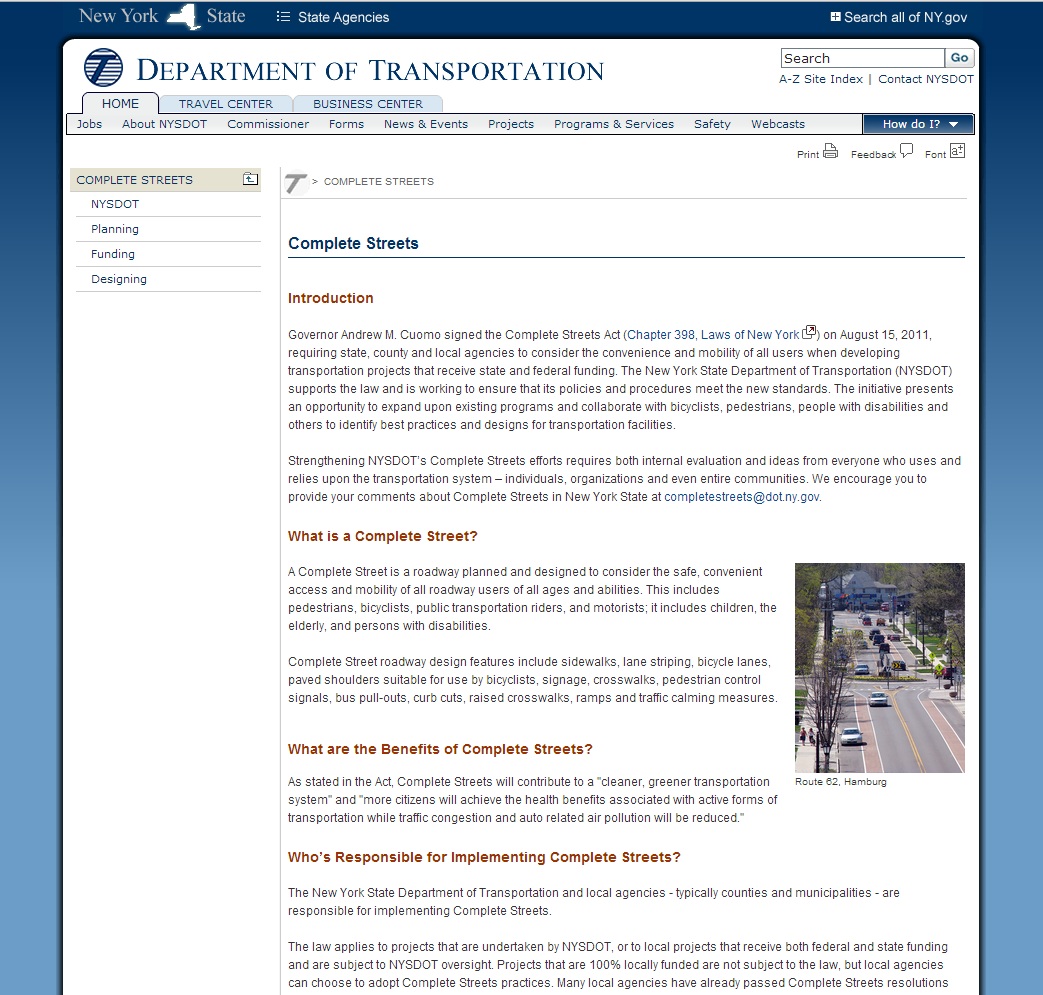
While the New York State Department of Transportation (NYSDOT) is not required to lead the local implementation of the State’s Complete Streets Act, municipal leaders, advocates and engineers are looking to the agency for the tools required to plan and execute Complete Streets initiatives. NYSDOT’s new Complete Streets website, however, provides little new information, or inspiration, for those seeking guidance.
The good news is that the Department is seeking feedback on how it can better assist local governments and others with Complete Streets. Here are Tri-State’s suggestions:
1. Revisit Statewide Pedestrian and Bicycle Planning. It is time for a comprehensive update to the State’s planning process for pedestrian and bicycling facilities. This should include sprucing up, expanding and ultimately adopting the Governor’s Traffic Safety Committee’s Pedestrian Safety Action Plan and creating a comprehensive Statewide Capital Plan for pedestrian and bicycling projects. Both of these items are important tools that could help convince our state and federal representatives to support implementation of these types of projects.
The website should also further highlight the planning resources that already exist. The “Planning” section of the website links only to a two-page 2010 NYSDOT Pedestrian and Bicycle Policy, and leaves out a 1997 pedestrian and bicycling plan and an associated 2005 white paper. Additionally, many regions have already developed their own Bicycle and Pedestrian Plans — links to those plans on this site would be helpful.
2. Update Pedestrian and Bicycle Design Guidelines. There has been a revolution in bicycle and pedestrian infrastructure design over the last few years. In addition to linking to the National Association of City Transportation Officials design guide for bicycles, NYSDOT should update their own guidelines: The “Designing” page of their website provides technical guidelines for Complete Streets elements like sidewalks and bicycle lanes, but it links to an outdated NYS Highway Design Manual (HDM), sections of which haven’t been updated since the late 1990’s.
3. Commit to Active Transportation by Funding It. More than a quarter of traffic fatalities are pedestrians and bicyclists, but only two percent of New York’s transportation dollars go to pedestrian and bicycle projects. New York must establish a Fair Share for Safety policy that apportions Highway Safety Improvement Program Funds according to need and create a dedicated line for pedestrian and bicycling investments in NYSDOT’s budget.
The website could also think more innovatively about funding. While the “Funding” page contains links to the Federal Highway Safety Improvement Program and the Transportation Alternatives Program, there is no link to the recently-announced Federal Transportation Enhancements Funding that’s currently available, and no mention of the possibility that NYSDOT might actually put their own money on the table, or shift some existing, and flexible, federal resources to projects that support walking and biking.
4. Look At What Your Neighbors Have Done. NYSDOT should consider looking into how other state DOTs share Complete Streets information. For example, both New Jersey and Massachusetts conducted Complete Streets training workshops for engineers, advocates and public works employees.

AASHTO revised its “Guide for the Development of Bicycle Facilities” only last year and is worth using as well as the NACTO guidelines, especially outside of New York City. Let’s not forget the purpose here is to encourage alternate modes of transportation, namely walking and bicycling. Accommodations for alternate modes have to be safe and sufficient.
In the end it’s all about the bucks (see #3 above). So let’s get those in the Legislature who championed Complete Streets to take this to the next level and secure funding for meaningful projects throughout the state.
[…] Tri-State: NYS DOT Could Stand to Ramp Up Its Complete Streets Program […]
[…] How NYSDOT Can Improve its Complete Streets Outreach Mobilizing the Region (NY) – May 14, 2013 While the New York State Department of Transportation (NYSDOT) is not required to lead the local implementation of the State’s Complete Streets Act, municipal leaders, advocates and engineers are looking to the agency for the tools required to plan and execute Complete Streets initiatives. […]
[…] municipal and county leaders to provide better assistance in implementing Complete Streets. The Tri-State Transportation Campaign has several ideas, including updating design guidance and offering […]
[…] but in order to ensure the region is not left behind other cities in advancing sustainable transportation options and the economic development that follows, communities will […]